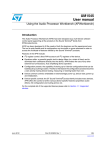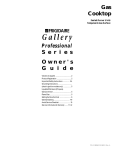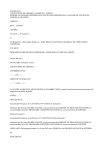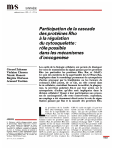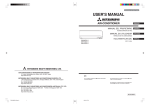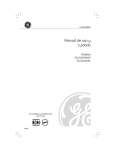Download ECU Case Studies - AeroElectric Connection
Transcript
Why you Should Know your ECU; Three Case Studies Reprinted by permission from the pages of CONTACT! Magazine PO Box 1382 Hanford CA 93232-1382 United States of America (559) 584-3306 (559) 585-0930 fax II This article came attached with the following note from Larry David, the person responsible for compiling and submitting this article. -Pat The article that George Moore, in Michigan, Graham Brighton, in Australia, and I, in California, collaborated on is attached. In addition to all three of us owning Subaru Legacy 2.2L engine powered KIS TR1 aircraft and having experiences with the OEM ECU to share, we did it all over the internet without ever having met each other in person. While the technology of the ECU and its mysteries caused us some grief, the technology of the internet helped us pull together this article and better understand the problems associated with the ECU. INTRODUCTION This article contains three case studies from current owners of Subaru engine conversions. These studies are provided in chronological order. George Moore's ECU experience was in 2001 while Larry David's experience was in 2006. If similar cases had been publicized earlier, both George and Larry might not have had such exciting experiences. Graham Brighton has provided the results of his ECU testing which he started when he heard about the prior ECU issues reported in the first two cases. We provide this information in the hope that other owners, builders, and pilots will not suffer our same experience. CASE STUDY ONE By George Moore, N6382G Jackson, MI [email protected] FIRST FLIGHT In October, 2001, I was finally ready for the first flight (or perhaps I should say first fright) of my just completed KIS TR-1 powered by a Subaru Legacy 2.2 liter engine. On the ground was Terry Lutz. Terry is the first American test pilot to land the Airbus A380 on its maiden flight from London to Kennedy Airport. Terry monitored the flight from the ground with a handheld radio while Tim Martinson flew chase in his beautiful RV-6A. Terry had taken me up in his Luscombe a few days earlier to show me all the possible emergency landing fields around the airport, one of which was the trap-shooters' field about two miles southwest of the airport. I was mentally prepared and ready to go, so I lined up at the end of runway one zero at Mason-Jewett Airport and with a dry mouth and a somewhat increased heart rate I pressed the throttle forward to full throttle. The airplane picked up speed quickly and with one notch of flaps the airplane rose into the air. I flew south but stayed within about five miles of the airport and kept the speed of the airplane no more than 130 miles per hour as I did not want to press my luck. Everything went very smoothly, except the left wing was somewhat heavy and I could not communicate with Terry Lutz on the ground. After trying some gentle turns and talking only to Tim Martinson because he was close by and could weakly pick up my radio transmissions, I decided to let Tim know that I was going to return to the airport and do a landing. The landing was great and I even impressed Terry Lutz, who was standing near the edge of the runway, and as I rolled past him Terry gave me a thumbs-up. I taxied back to the hangar and the three of us danced around like idiots indicating unspeakable joy. A few days later I did a second cautious flight and once again all went well as my confidence was now building. On the third flight a few days later, I decided to fly west from Mason-Jewett Airport and check out my radio to ascertain what may be the difficulty. As it turned out, it was a defective device that I had installed on my instrument panel that was supposed to allow me to use a hand held radio (as a backup) connected to the aircraft's antenna. Not being able to reach Lansing approach, I decided to increase my altitude from 3,500 ft to 4,500 as I was flying west. I again tried the radio; no response from Lansing, so I decided to push the throttle to near full and see just how fast this little bird could split the air. After about a minute with an rpm of 4,300, suddenly and without warning the engine shut down with a slight cough but continued to idle. I never felt so alone in my life! Immediately, while turning back 180 toward Mason-Jewett Airport, I went through the emergency procedures and set up a glide (o.k., but what speed? I had not yet established the best glide speed with this being only my third flight in this airplane). 0 I scanned the fields below me. For the past two weeks it had been raining heavily and the ground was saturated with water. I saw a corn field to my right, but rejected it as a poor choice. I kept gliding toward Mason-Jewett Airport ...... then, finally, I saw the trap shooters' field dead ahead. I still had enough altitude, so I mentally planned my approach. Using my flaps as a control for descent I first clicked in one notch, maintaining 90 mph. I was still a little high but saw a ditch on the west end of the field and knew I had to get over that. I pulled full flaps but then went back to one notch, only to immediately go back to full and concentrate on my final approach. The landing was perhaps the most beautiful landing I have ever made and I touched gently onto the sod. Heaving a sigh of relief I relaxed, but should have immediately applied brakes and shut down the engine. As I rolled out with the engine still idling and slowing down somewhat, suddenly a slight depression with an elevated roadway appeared right in front of me and so, while applying brakes and saying something like "oh my goodness, gracious," (in reality, I really said, &#@!) The propeller dug into the soft ground throwing clay pigeons and dirt over the left wing and the airplane stopped abruptly. Three men walking a dog in the area observed my approach and touchdown. One of the men lived at the site and offered me his pole barn where he said I could effect repairs. This was a very kind gesture, but I declined stating that I had to secure the services of a flatbed truck and get the aircraft back to the airport, only about 2 miles away. The other man who had a pickup truck and dog offered me a ride back to the airport, an offer I accepted. Jack Tomen watched me leave via airplane and was astonished to see me get out of a pickup truck right in front of his hangar where he was working on his project - a Kitfox. Jack's mouth dropped open and said, "George, where is your airplane?" I wanted to tell him that I was a magician and that I made my airplane disappear, but instead I explained what happened, thanked the kind gentleman who had returned me to the airport and Jack dropped everything and agreed to use his SUV to chauffeur me to a towing service nearby. The rest is rather uneventful only to say that we had a convoy of two police cars ahead, followed by a tilt-bed truck with the airplane sitting proudly (or ashamedly) on that truck bed with Jack and me following right behind. We drove through a residential area where gawking children stopped their play to look in wonder at this white airplane on a truck bed as we slowly moved past. PROBLEM ANAL YSIS At first I mistakenly thought it was a blocked fuel filter or at least it was somehow related to the fuel system. I hadn't heard of a "limp home" mode but soon got educated as to what actually happened that fateful day. The "limp home" mode occurred at about 4,250 engine rpm in my Subaru Legacy engine and the reason my buns had been spared is the fact that I had installed a 68 x 76 prop (over pitched for that power of engine) which never al- lowed the engine to crank up to more than 4,200 rpm on takeoff. Lucky me! I have since replaced the propeller with a 68x72, although that, too, is a little over pitched, though I am doing quite well with the newer prop. I then got in touch with the engine mod factory and indicated my displeasure and that I expected immediate help to fix this thing. A factory team of two flew into Detroit Metro, rented a car and drove to Mason Airport and I met them at Mason-Jewett Airport in front of my hangar at the appointed time. A Subaru portable engine analyzer was used to read the codes, then it was determined that the engine power failure was indeed the so called "limp home" mode. THE SOLUTION The cure was to use the wire from the ECU which normally is connected to a tachometer on the instrument panel, and divert this to a digital frequency divider. Thus, whatever the tach signal read, the divider returned the now divided signal to the ECU as half of the engine RPM. The engine would never be able to generate a high enough signal (double 4,250 or about 8,500 rpm) to place it into "limp home" mode. To get the tach pulse the engine team spliced a wire from the ECU to the igniter. This pulse is 1/2 the engine rpm and closely approximates the prop rpm (though the gear ratio for the prop is 1:1.8, not 1:2), so I mentally add 200 rpm to the new tach reading to closely figure the actual prop rpm. I have not had another problem since and I have been flying my airplane (including full throttle) for 5 % years, 195 hours since that most interesting day. I do use about 80% power for cruise and have the utmost confidence in the engine. CASE STUDY ONE CONCLUSIONS One comment I would like to make is that I do not like the idea of trying to modify the ECU other than using the frequency divider as indicated above, as ECU's are very complicated devices with so many parameters that messing around with the electronics is taking the chance of messing up something else. The cure is really very simple: use a simple, digital frequency divider that is easily purchased at almost any electronic parts supply house. One more thing; as auto engines with a PSRU installed will usually run sans propeller (because they are fitted with a flywheel), test an auto engine before flying by removing the propeller and run up the engine to a little above 4,600 rpm for about 2 minutes. If the engine goes into "limp home" mode, you have a problem that will need to be addressed. As I have mentioned above, the simplest way to solve this issue is to add is to add an inexpensive device - a digital frequency divider. I hope this helps someone out there avoid the very serious problem of power failure when using an automobile engine conversion which has this feature built into the ECU. George Moore _ _ _ CONTACTlIsSUE88PAGE4 CASE STUDY TWO By Larry David, N506RJ Thousand Oaks, CA INTRODUCTION My case began with an ad for a plane for sale on eBay. The plane was a KIS TR-1, twoplace, low winged, fiberglass airplane powered by a 2.2 Subaru automobile conversion. I dilly-dallied and did not get around to bidding while the plane was listed. Later, I tracked down the seller and made him an offer and became the proud owner of N506RJ. The plane was signed off for flight by the . . . original builder, but had been N506RJ before Its first flight on January 3, 2006 stored outside in the Phoenix sun for a couple of years Each of the taxi tests at progressively higher speeds after the original builder had decided (with the "help" of gave me confidence in the plane, engine, and propeller. his wife) to donate the plane to a charitable organization. It became a series of test a little, fix a little, test a little, fix a little and repeat the process until everything was looking good. The KIS kit was manufactured by Tri-R Technologies in Oxnard, CA. The initial builder of N506RJ was a semiFIRST FLIGHT retired dentist in the Phoenix area and this was his fourth successful homebuilt aircraft project. The engine was On January 3, 2006, I did a series of final taxi tests on a from a 1991 Subaru Legacy and was coupled with a remedy to a nose wheel shimmy. Every thing was fine at Ross Engineering reduction drive. The propeller was an taxi speeds in 5 MPH increments from 50 to 80 MPH. At in-flight adjustable IVO Magnum. The engine had the 80 MPH, I gave slight aft pressure on the stick and the original equipment manufacturer (OEM) Electronic Conplane leapt off the runway and was almost instantanetrol Unit (ECU). ''The ECU receives signals sent from ously doing 100 and climbing rapidly. With a big smile on various sensors and switches to judge the engine operatmy face, I immediately turned crosswind, then downwind, ing condition and emits output signals to provide the optiand had to pull the throttle back a bit since the plane was mum control and/or functioning of various sysnow doing 120. After stabilizing the speed at 100, I protems." (Source: page 13, Subaru Legacy 1991 Service ceeded to turn base, then final, and touched down at 100 Manual, section 2.) mph. The plane flew and landed beautifully with no shimmy or vibration, so I concluded that my vibration This was a 90% completed project. You have heard of repairs were successful and coincidentally the first flight the 90-10 rule. It takes 10 percent of the time to get a was magnificent. I was very pleased with the plane's perproject 90% completed and 90% of the time to do the formance at partial throttle. last 10%. While I had joked about that rule for many years as a systems engineer, I experienced it first hand I spent the next couple of days reinspecting everything, as an aircraft builder during the four years I completed retorquing the prop, and getting ready for my second the construction of the plane. flight. I did a couple of full throttle ground run-ups to check out the engine. These were all rather short duraOne of the most challenging and most rewarding parts of tion and no problems were indicated. My flight plan for building (or finishing in my case) an experimental aircraft the next test flight was to do a full throttle run-up, full is the testing process. After reassembling the aircraft throttle taxi and take off at 90 MPH, climb out at 90, level from its trip by trailer from Mesa, AZ to Camarillo, CA, I at about 4,500' over the field. There I would do some started the process of finishing and testing it. There were stall testing to determine actual stall speed, slow flight a number of major things that resulted from the two testing to determine slow flight characteristics, and flap years of neglect while the plane sat out in the Phoenix testing to determine flight characteristics with flaps desun. A cracked windscreen needed to be replaced, major ployed at 1, 2 and 3 notches at various speeds. fuel tank leaks had to be repaired, and the weak nose THE EVENTFUL DA Y gear was replaced along with numerous cosmetic details. As things were fixed, the testing began in earnest On January 10, 2006, I verified that I had 4 gallons of with a series of ground run-ups that identified expected fuel in each tank, taxied out to the run-up area and did a full throttle preflight. Everything was fine. Then I taxied things like fuel, oil, and water leaks which were not surout to runway two-six, commenting to the tower that prising and were all easily remedied. Taxi testing found various vibrations and shimmies that were also fixed. while they were reporting a slight tail wind, the birds sit- :. ting on the wind sock indicated no wind. When cleared for take off, I gave the plane full throttle, accelerated to 90 MPH in about 15 seconds (estimated), rotated and began climbing at 90 MPH. Between enjoying the view and the ride I was checking speed, altimeter, engine rpm, stick forces, looking for any vibrations, and mentally running my check-list. The field was quickly dropping away beneath me. - Crash site Then I became aware, sensed as it were, that something had changed. There was no pop, bang, thud, vibration, or anything to indicate a problem. The prop noise level and exhaust noise level did not change. The engine was running smoothly. I just sensed that I was going slower which I confirmed with the airspeed indicator which read 60 now instead of the 90 MPH it had indicated brief seconds before and the altimeter indicated 450 feet and was unwinding. The tachometer was indicating about 2,000 RPM, the prop was still spinning (at about 1,100 RPM), and I was moving, but slower and not climbing. This was not exactly what I had planned for. THIS CAN'T BE GOOD When I noticed the check engine light had come on, I was convinced that I was experiencing a "limp home" situation like that experienced by George Moore, another KIS owner in Michigan, and described in case study 1 of this article. (After the "off field landing" people asked me if the first thing I thought was "Oh sh--! ", but strangely enough that thought never occurred. Instead my emergency training kicked in and I busied myself with emergency procedures.) I jacked the throttle in and out to no avail. Recalling that turning off the ignition switch was supposed to reset the ECU, I tried that twice ... also to no avail. I checked the fuel pressure and the fuel pumps, they were all fine and the engine was running. As I was doing this, I was looking out and there was an empty commercial growing field straight ahead, the center of which was smack dab in the middle of my windscreen. As I looked down at the runway and concluded I was too high to get down to the little bit of runway available below and ahead of me. About that point in time, probably five or ten seconds after noticing the problem, I advised the tower that I had lost power. I did a quick visual check of the field to the left and it was full of field workers. I checked the freeway to the right and it was full of cars. I looked straight down and concluded I was not high enough to go around. So _ - - , :1 , 1 ~ .' . ~ Limp-home mode started here there I was, too high to get back to the runway and too low to go around. What a way to start the morning. The center of the field in front of me was still frozen in the middle of my windscreen so I concluded I was on a trajectory to that spot in the middle of the field. About that time, the tower requested my intentions and I muttered something about having to put the plane down. Things were running through my mind pretty fast and this was about the time that I recalled what had come up in a hangar discussion the week before. One of the fellows mentioned that the famous pilot and air show performer Bob Hoover has once said something to the effect that if you are going to crash, fly as far into the crash as you can and as slow as you can. With this thought in the back of my mind, I continued evaluating the situation. Here are a couple of complicating factors that raced through my mind: • All the things I could use in making the landing, such as flaps, slow flight characteristics, and stall speed had not been determined or tested. Not a cheery thought. • Several of the KIS TR 1s had demonstrated a tendency to drop the nose at slow landing speeds in ground effect, resulting in bent nose gears and prop strikes. Not wanting to lower the nose to increase my speed for fear of overshooting my landing spot and going into the hot house structures in the next field, I figured I had better land tail low, the best chance of not snapping the nose down and flipping over. • A short distance beyond the end of the runway was a flood control ditch full of rip rap (large boulders) that ran perpendicular to the runway. Obviously, my survival depended on clearing that ditch so whatever I did I had to clear that obstacle. • A short distance beyond that flood control ditch was the airport property security fence which is about 6 feet tall. This obstacle, while worrisome, was probably not lethal if I plowed into it. CONTACTIISSUE88PAGE6 N506RJ after its second flight, at rest in the celery field adjacent to the airport. settled, I opened my eyes and the remainder of the cel• The actual stall speed of this plane had not been ery crop was just beyond my feet. The nose of the plane determined. Some of these planes had been rehad taken a left turn probably because the engine was ported as stalling as fast as 70 MPH - a rather worristill running and the prop was still turning at about 1,100 some thought. The advertised stall speed was 58 RPM. I estimate that I decelerated from 88 FPS (60 MPH and fortunately for me because the plane was MPH) forward speed (and about 8-10 feet per second so slick, I was doing 60 (and had not stalled yet). I descending) to zero in about 30-40 feet. My tail low strathad a 2 MPH margin of error before I might stall anegy worked in the soft field. The plane had not flipped other worrisome thought. With only a small margin over. The main gear was located about 30 feet behind for error/stall, I opted to not try to make any turns the final resting place. The folks who removed the plane and the field straight ahead was still in the middle of from the field said the nose wheel had nicely folded back the windscreen and looking better and better. under the plane and gouged a ditch about a foot deep • The commercial growers use a planting bed techand about 6-8 feet long that was visible when they lifted nique where the field length growing beds are about the plane onto the truck. four or so feet wide with a trench about a foot wide and a foot deep separating each bed. The trenches Based on the adage that any landing you can walk away are used for the farm machinery to drive in, for wafrom is a good landing and if you can use the plane tering the fields, and for field workers to stand in again, it is a great landing. This would qualify as a good when working the growing beds. I was approaching landing. I walked away from the landing with a little help this field perpendicular to the trenches and growing from the rescue helicopter folks. I also got a free helicopbeds and not inclined to try any sort of turns. The ter ride and got to know a lot of really nice people at St good news is the fields had recently been picked so I John's Medical Center in Oxnard. would not be damaging any crops and the fields were relatively soft. I figured when I touched down it WHA T HAPPENED or would be rough crossing the beds and dusty (which POST CRASH ANAL YSIS it was). All indications are that the OEM ECU sensed some condition that it was programmed to believe was catastroHaving considered all the possibilities I could think of, I phic for the engine and shut it down to "limp home" concentrated on my approach. It appeared that my mode. In an automobile, this is a very handy feature slightly controlled trajectory would clear the flood control since it allows you to limp home at 20-25 MPH so you ditch and the perimeter fence. The middle of the field can get it fixed, but not so good for an airplane. was still frozen in the middle of my windscreen and had become a welcome sight to me. I was able to maintain a It appeared that when the engine was run at full throttle tail low attitude. The plane behaved great on the apfor some predetermined length of time (in my case it approach and thus far was uneventful. peared to be about a minute at about 4,600 RPM), the Now the landing was something else. As soon as the tail ECU reduced the power down to about 2,200. Probably the reason it didn't happen during the first flight was I touched down, I grabbed the stick with both hands and was only using partial throttle. The previous occurrence pulled back with all my might, closed my eyes, gritted my of limp home (in Michigan) happened at altitude after the teeth and held on because from that point on it was a pilot completed his climb and started a high speed test sled ride. There were scraping, grinding, and tearing run (see case study 1 for details). Larry David sounds as I was bounced around a lot. When the dust CONCLUSIONS and RECOMMENDA TlONS 1. 2. Case Number Three By Graham Brighton, N202DR Victoria, Australia [email protected] Based on George's and Larry's experiences in case studies one and two, I was a bit apprehensive about my recent purchase of a Subaru powered KIS. I had already exported it from the USA to Australia so I had to find out what the situation was before I bent my new plane. The laws here require I use the talents of local mechanics do all my work, so I enlisted the services of several different "experts" claiming Subaru ECU experience in order to better understand the ECU behavior, with the hopes of avoiding the same experiences as George and Larry. Our testing has determined that somewhere above 4,000 RPM, the ECU turns off one or two of the four injectors, leaving the engine running on in "limp home" mode. In a recent email to Larry and George, I reported that with the engine set up to Subaru specs, I have limp home mode indicated at low revs and can throttle up and go though the limp mode to the mid-throttle range (say bout 2k ish to about 3,750 or so RPM) where limp mode is not present and normal running returns. But then Limp mode returns again just prior to 4k rpm. So with throttle movement in my installation, I can throttle back and forth through limp home mode. From what I understand from their experiences, once they have encountered limp mode, the engine was stuck in that mode. That is not the case with my engine, but keep in mind that my runs are only static, i.e., aircraft chocked and stationary on the ground. I have a ground adjustable 3 blade propeller that has lots of pitch (don't know the exact amount). Full throttle run up only gets to a tad under 4k RPM when limp home mode kicks in. However, while in this mode, at this throttle position, the engine revs come back to about 3,500 RPM (so maybe only one injector is being shut down?). Two injectors are definitely shut down with the low throttle position limp mode. This testing experience adds even more reason for each owner/builder to know his ECU and its behavior under Graham Brighton various operating conditions. _ 3. If you convert an automobile engine to power an aircraft or if you are already using such a conversion, learn about the ECU and know exactly what the ECU is going to do under all operating conditions. In Larry's case, maximum power for about a minute resulted in a broken plane. Thorough testing like Graham is doing would have prevented this outcome. Modifying the tach signal such as George has done would also have prevented the problem. When flight testing, get as high as possible as soon as possible. In Larry's case, he used too much of the 6,010 foot runway with the 90 MPH speed (90 MPH covers 132 fps or 7,920 feet per minute). Calculations by the late Vance Jaqua indicated at that 90 MPH in the KIS, it should have been climbing at over 1,500 feet per minute, but in fact, after about a minute the plane was only at 450 feet. This suggests the limp home mode occurred in less then a minute. Testing like Graham is doing would confirm the exact behavior of the ECU. Always plan for and anticipate that the engine could quit or lose power on take off. Larry is often heard muttering "over 30 years of flying without an incident and then this." So it can happen and like Murphy's Law, it will happen at the worst possible time. Footnotes: The 1991 Subaru Legacy Service Manual never clearly describes the "limp home" mode. On p.24, section 6, in the self-diagnosis system describes that the selfdiagnosis system detects and indicates a fault in various inputs and outputs and turns on a warning lamp (Check Engine) to indicate a fault has occurred. "Further, against such a failure or sensors as may disable the drive, the fail-safe function is provided to ensure the minimal drivability" which is as close to "limp home" as I could find. Then, on p.25 in the second footnote on that page the manual states ,,** When the engine operates at a speed greater then 2,000 RPM for more then 40 seconds, a trouble code is emitted." I could find no statement as to what will happen after a trouble code is emitted. However, on p. 26, in Table 5. TROUBLE CODES AND FAILSAFE OPERATION there are descriptions of 23 trouble codes. Ten of those codes have a Fail-Safe operation described. Two of those descriptions, while not very clear in what they say, do appear to be worrisome. Code 23, Air flow sensor's fail-safe operation is "Controls the amount of fuel (injected) in relation to engine speed and throttle sensor position." Code 24, Air control valve's failsafe operation is "Prevents abnormal engine speed using "fuel cut" in relation to engine speed, vehicle speed and throttle sensor position." Trying to assimilate and integrate these facts, I think it says when the engine runs for 40 seconds at greater then 2,000 RPM, the ICU will start doing things and a couple of them involve reducing the fuel. That's as close as I could come to finding anything about "limp home" in the Subaru documentation. Larry David [email protected] CONTACTIISSUEBBPAGEB









